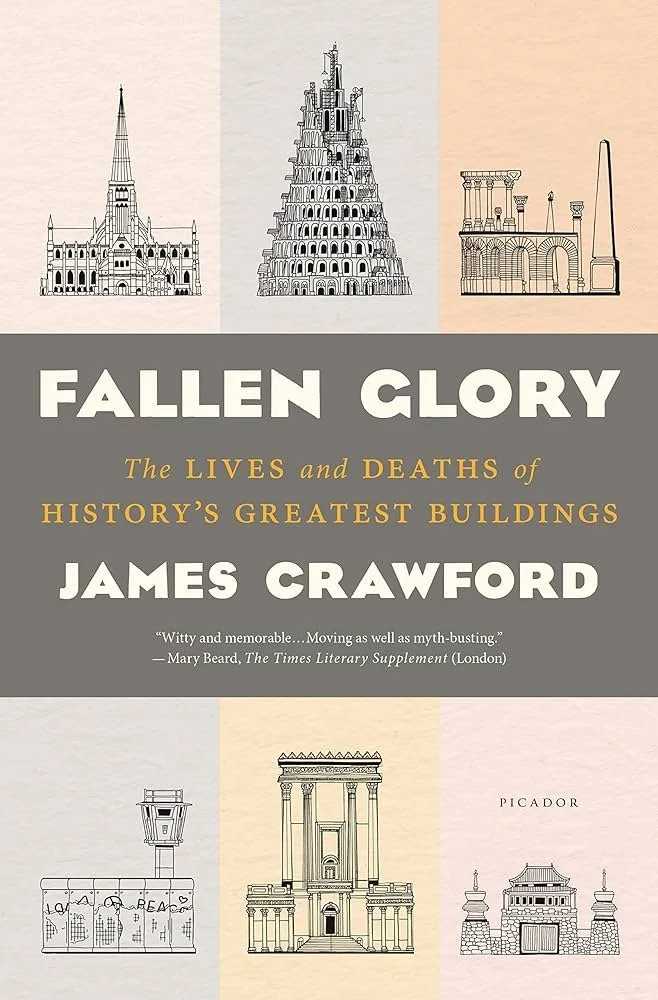Book Review: Fallen Glory
/Fallen Glory: The Lives and Deaths of History's Greatest Buildings
by James Crawford
Picador Press, 2017
As James Crawford points out in his delightfully overcrowded new book Fallen Glory: The Lives and Deaths of History's Greatest Buildings, the spaces humans create for their public and private lives have always been more than mud and brick and thatch. They come to be parts of our lives, indeed to be participants in our lives:
There is no question that we invest our greatest structures and constructions with personalities. We care about buildings – sometimes, perhaps, more than we care about our fellow human beings. We shout with joy when we raise them up; we weep with sorrow when we destroy them. And, of course, we do continue to destroy them – buildings young and old, all over the world.
“If we let them,” he tells his readers, dreamingly but quite correctly, “buildings have the potential to be the ultimate raconteurs.”He's no slouch himself; Fallen Glory is full of stories about the lives of buildings, mostly famous buildings, mostly famous and wantonly destroyed buildings. The great temples of antiquity round out the book's early chapters, as well as that most famous of all non-temples, the Library of Alexandria, a shabby, flea-ridden barn of a place, no bigger than a AAA baseball park, that is routinely touted as the pinnacle of all learning by pundits who couldn't pick Spain's Biblioteque Nationale out of a police lineup. Crawford moves through the Middle Ages and the Renaissance and steadily onward to the present day, always providing copious historical digressions (the short of patience should be warned: as enjoyable as these digressions are, they often stray very far afield from any focus on architecture), always highlighting the very human elements of the building and demolishing of cherished places.“Are buildings extension of us – of our power, piety, wealth, taste and refinement?” Crawford asks. “Or are we extension of them – mere products of environment designed to control how we feel, think, and behave?” He calls it “the nature-versus-nurture debate in stone, steel, glass and concrete,” and that symbiosis was never more painfully spotlighted in American history than in the terrorist attacks of September 11, 2001, when architect Minoru Yamasaki's ugly, iconic Twin Towers fell to the ground with thousands of occupants still inside them. Crawford devotes an entire chapter to the World Trade Center, and it makes for powerful reading:
Nearly a century earlier, the famous American architect Frank Lloyd Wright had volunteered a morbid prediction about the fate and future of the skyscraper: 'Millions of tons of brick and stone go high up into thin air by way of rivets driven into thing webs of perishable steel. Therefore millions of tons of stone and brick will have to come down again. Come down when? – Come down how?' September 11 provided an answer that few could have imagined, let alone anticipated. The terrorists' impossible aim was for the towers to collapse. And somehow, they succeeded. 'No visionary cinematic genius,' wrote [Martin] Amis, 'could hope to recreate the majestic abjection of that double surrender, with the scale of the buildings conferring its own slow motion. It was well understood that an edifice so comprised of concrete and steel would also become an unforgettable metaphor.' In those minutes, the greatest story of all – history itself – was consumed by the black hole, by Ground Zero.
Of course, the Twin Towers are an anomalous case in the record Crawford draws: yes, they were raised with a good deal of hope and hoopla, but they weren't demolished by civic or commercial processes. In most of the stories brought so wonderfully to life in Fallen Glory, iconic buildings are destroyed not by warfare or hatred but by sheer, maddening obliviousness, by clueless bureaucrats and greedy developers either not seeing the beauty they were razing to the ground or not caring.
For New Yorkers of a certain age, the maddening prototype of this will always be Penn Station, and of course the citizens of Boston know the feeling well, since half that dear old city's best buildings are parking lots now. Crawford identifies this as the central dynamic of mankind's love affair with its own architecture: “Since the creation of the very first structure, a tension has existed in architecture – between utility and ornament, beauty and function.”Fallen Glory is a stunning – and saddening – testament to that fundamental tension, and a history of it. The book is well worth finding in your drab, boxy, inconvenient local library.

